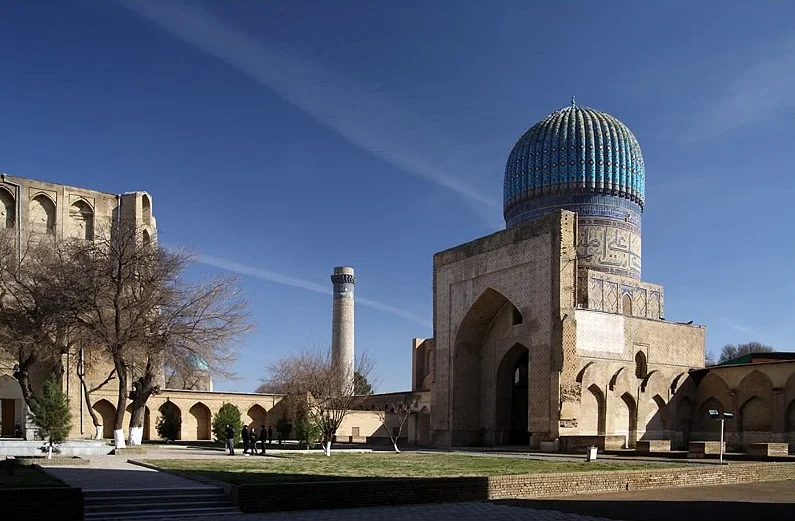Samarkand is one of the most ancient cities in the world, whose worthy age of 2750 is on a par with Rome, Athens and Babylon - it was originally known as "Maracanda". A great trading city of the past, the capital of many kingdoms - from ancient Sogdiana to the medieval empire of Tamerlane - Samarkand is considered the birthplace of the world famous Samarkand silk paper. High quality silks and velvets, jewelry and stained glass were produced there.
Today, this second largest city of Uzbekistan with a population of over 400 thousand people is a harmonious combination of the modern economic achievements of independent Uzbekistan with the charm and grandeur of the world famous architectural monuments of Samarkand, listed by UNESCO as a world heritage.
1. The Registan Square
Registan Square is the "heart" of Samarkand. The social and official center of Samarkand today consists of three grandiose buildings: Ulugbek Madrasah (1417-1420), Sher-Dor Madrasah (1619-1636) and Tilla-Sheikh Madrasah (1619-1636). All buildings are richly decorated with glazed bricks, majolica tiles and carved - the so-called "kashina" - mosaics, the buildings have retained their original appearance and high spirit of medieval Muslim culture.
 |
Registan Square, Sights of Samarkand |
2. Mausoleum of Gur-Emir ( Gur-Emir mausoleum)
Gur-Emir can be translated from Persian as "tomb of the emir." It was originally built by Tamerlane for his beloved grandson, Muhammad Sultan, who died in 1403. Later, this place became the burial place of Tamerlane himself, his two sons - Miranshah and Shakhrukh - and his grandson, the great astronomer Ulugbek.
The mausoleum is a monocotyledonous structure with a burial vault. The octagonal body of the building is crowned with a ribbed dome (14.5 m in diameter, 12.45 m in height) on a high drum. The dome is the main decorative element of the mausoleum. Thick turquoise blue twisted stripes make the dome particularly expressive.
3. Mausoleum of Khoja Doniyar (The Haji Daniyar)
The mausoleum is one of the most important places of religious pilgrimage in Samarkand, equally revered by representatives of three world religions: Muslims, Christians and Jews. The name of the place has a connection with Daniel from the Old Testament, the one who calmed the lions in Babylon's box. They say that the sacred remains were brought by Tamerlane from the Iranian city of Shush (ancient Suzy) during his 7-year campaign (1399-1404) against Iran, Turkey and Syria.
 |
| Mausoleum of Khoja Doniyor, Samarkand Landmarks |
4. Bibi-Khanum mosque
Bibi-Khanym is the most ambitious and ambitious project implemented by Tamerlane in Samarkand. Since it was completed shortly before the death of Tamerlane (in 1405), the mosque began to deteriorate rather quickly, which is probably due to the haste in which it was built. This unique mosque was built in just 5 years, which is clearly not enough time for such a huge structure.
The Bibi-Khanym Mosque, an amazing landmark of Samarkand, can accommodate more than 15,000 believers at a time, which is an impressive embodiment of the ambitions of the great ruler, the skills and talents of medieval architects, whom Tamerlane skillfully collected from all corners of his vast Empire.
 |
| Cathedral Mosque Bibi-Khanym, Sights of Samarkand |
5. Nekropolis Shahi-Zinda
The name means "Living King" in Persian. This is a huge necropolis from the time of Tamerlane (14th century AD), where mausoleums stretch on either side of the paved sidewalk at the southern end of ancient Afrosiab. The Shakhi-Zinda necropolis is a unique place where an ensemble of mausoleums of the Samarkand nobility is assembled . Some of the mausoleums are small, but in miniature they have the same architectural and decorative features of portals, mosaics and slabs as other buildings of Tamerlane.
The name of the ensemble comes from the legend that the grave of the Prophet Muhammad's cousin, Kusam ibn Abbas, is located here. Therefore, this place among the Muslims of Central Asia is highly regarded as one of the most important places for pilgrimage.
 |
| Shakhi-Zinda Necropolis,Sights of Samarkand |
6. The Observatory of Ulughbek's
One of the most advanced and famous observatories of the Middle Ages and another unique sight of Samarkand and Uzbekistan, which is worth a separate excursion around it. It was built in 1425 on top of a high hill called Kuhi Rasad. There, at the observatory, worked the grandson of Tamerlane and the Samarkand ruler of that time, Muhammad Taragay Ulugbek, who was helped by a team of astronomers and mathematicians, he observed stars, constellations and planets for 12 years, making astronomical measurements, making calculations that ultimately allowed him to create the world famous "Zijdi Guragani" - a catalog of coordinates of 1118 stars with incredible accuracy at that time.
Today you can see the remains of a sextant, found in 1908 during archaeological work, the basement of the observatory building, which was originally 30 m high and 40 m in diameter, and a small museum.
 |
| Ulugbek Observatory, Samarkand Landmarks |
7. Mausoleum of Ruhabad (Ruhabad mausoleum)
The Rukhabad mausoleum was built in 1380 by the order of Amir Timur on the site of the grave of the theologian, great Islamic preacher and mystic scholar Burkhaneddin Sagardzhi. It is believed that the very burial of the preacher dates back to the 10th century.
 |
| Mausoleum of Rukhabad Samarkand |

